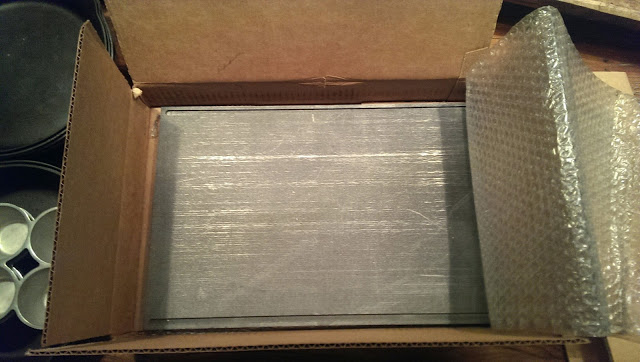Some of you may have already read about or looked into using graphite as the anode for your electrolysis tank. I had pondered it for a while, saw a few sources on Amazon, and procrastinated because of the perceived expense. About the best I could find there was a 1 square foot plate for $35 plus shipping. I then read some online discussion which included a link to an eBay seller offering surplus plates approx. 12"x18"x3/8", quantity of two $20 plus shipping.

The plates arrived intact, and, even though my charger connectors were overdue for maintenance, I just had to hook it up anyway to see what would happen.
The pan I chose had been in the lye bath for weeks, and had some areas of really tough carbon remaining the lye would not budge. Once powered up, the pan started fizzing away just like with my old sheet metal anode. Within an hour or so, the carbon residue had loosened and begun to shed off. Probably would have gone faster had I first replaced the rusty old clamps with new.
Once it had done all it appeared it could, I took the pan inside to rinse and season it. I first rinsed it under cold running water, as is my custom. Drying it off, I noted the paper towel becoming quite blackened, although a residue was not apparent to the naked eye. I also noted, as I went about gathering the usual items for seasoning, the pan showed absolutely no signs of flash rusting. So, for experimental purposes, I stopped and left it unseasoned. That's been over a week ago, and it still has not rusted. :icon_scratchchin:
I now need to acquire a rusty pan to give it a proper test, and also to see if the no flash rust thing happens again or was just a fluke. I have an old Lodge hammered piece this also once happened with.

The plates arrived intact, and, even though my charger connectors were overdue for maintenance, I just had to hook it up anyway to see what would happen.
The pan I chose had been in the lye bath for weeks, and had some areas of really tough carbon remaining the lye would not budge. Once powered up, the pan started fizzing away just like with my old sheet metal anode. Within an hour or so, the carbon residue had loosened and begun to shed off. Probably would have gone faster had I first replaced the rusty old clamps with new.
Once it had done all it appeared it could, I took the pan inside to rinse and season it. I first rinsed it under cold running water, as is my custom. Drying it off, I noted the paper towel becoming quite blackened, although a residue was not apparent to the naked eye. I also noted, as I went about gathering the usual items for seasoning, the pan showed absolutely no signs of flash rusting. So, for experimental purposes, I stopped and left it unseasoned. That's been over a week ago, and it still has not rusted. :icon_scratchchin:
I now need to acquire a rusty pan to give it a proper test, and also to see if the no flash rust thing happens again or was just a fluke. I have an old Lodge hammered piece this also once happened with.
